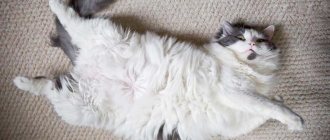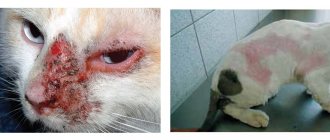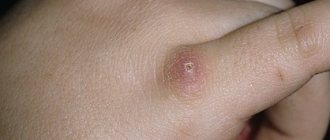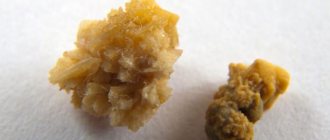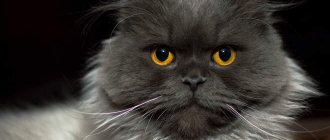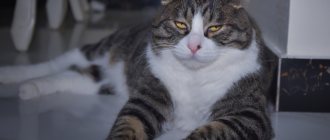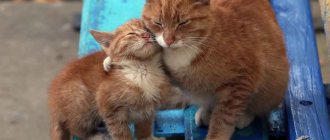Save article:
Urolithiasis (UKD) or urolithiasis is a serious disease of the excretory system in which sand and urinary stones accumulate in the cat's bladder, kidneys or ureters. The disease not only worsens the well-being of animals, causing them to suffer, but also directly threatens life. ICD has a certain set of symptoms that can be used to suggest the development of pathology. In case of a confirmed diagnosis, veterinarians use complex therapy and recommend effective measures to prevent urolithiasis.
Causes of ICD
There are many factors that contribute to the development of urolithiasis. All reasons are conventionally divided into external and internal. In this case, a combination of several provoking conditions is possible.
Exogenous
External causes are related to the living conditions, activity, and nutrition of the cat. One of the first places is irrational nutrition. An imbalance of proteins, fats, and carbohydrates leads to a shift in urine pH to the acidic or alkaline side. In both cases, solid conglomerates begin to form in the urinary organs. Vitamin deficiencies are also related to diet. All biologically active substances are important, but this is most true for vitamins A and D. Vitamin deficiency leads to metabolic disorders.
Thirdly, the lack of water and/or the high saturation of the liquid with minerals affects it. This factor affects the concentration of urine. In a more saturated liquid, solid inclusions form faster. The need for water increases if the cat lives in hot home conditions.
For some scrupulous cats, the cleanliness of the tray is important. Dirty litter makes the animal endure. Retention of urination provokes and accelerates stone-forming processes in the urine. In this case, signs of the disease appear faster.
Urolithiasis in cats is most often recorded at the very beginning of autumn, as well as in January-April.
Endogenous
Hormonal disorders can lead to the development of urolithiasis in cats. Internal causes also include diseases of the digestive system. If the food contains enough nutritional and biologically active compounds, but the cat has intestinal problems, the valuable substances will be poorly absorbed by the body. It is endogenous reasons that explain why cats of one breed or another are prone to urolithiasis. A set of genes, changes in their activity or structure influence the occurrence and rate of progression of urolithiasis in cats.
Symptoms of urolithiasis in cats
global $ads_google; //data-ad-slot=”2475549904″ $ads_google = empty($ads_google) ? false : true; ?> if ($ads_google == false) {?>
$ads_google = true; ?> } ?>
Problems with the lower part of the excretory system manifest themselves in behavioral signs at the earliest stages. The cat becomes apathetic and its appetite may change. The more the disease progresses, the more obvious the symptoms appear. In this regard, three symptomatic periods are distinguished: early, acute and critical. At the first stage, when sand and stones are already present in the bladder, urolithiasis in cats can be judged by the following signs:
- The pet goes to the toilet more often, and sometimes in the wrong places.
- Urination occurs in a tense position.
- While in the litter box, the cat meows from the pain caused by the stones.
- The presence of blood cells causes the urine to turn pink.
- The cat takes longer than usual to lick itself under its tail.
During the severe (acute) stage, these symptoms become even more obvious and others join them. The animal has urinary incontinence in a small volume, and the color of the liquid itself becomes more saturated. Urine acquires a specific unpleasant odor. Touching the belly causes pain in the cat. Body temperature jumps to 39-40 degrees.
In critical condition, the signs of urolithiasis worsen even more. The pet practically does not go to the toilet, and the urge causes severe attacks of pain. An overfilled bladder can lead to rupture and peritonitis. Viscous, foamy saliva is released from the mouth, and vomiting is possible. The temperature drops to 35-36 degrees. Body tremors and convulsions are added to apathy and lethargy. In the most severe cases, loss of consciousness is possible.
Urinary cylinders
Precipitates without a specific structure. They are formed from exfoliated tissue elements, blood and inflammatory cells, and a large amount of matrix substance. Crystalline components are not always present in urinary cylinders. If they are found in mineral components, they are often formed by struvite. Uroliths and casts are physically different and occur for different reasons and are more often found in males than females. The urethra is narrower in cats and urinary cylinders can cause partial or complete obstruction. Idiopathic cystitis is one of the factors contributing to the formation of urinary casts.
In case of obstruction of the urinary tract by urinary cylinders, it is necessary to eliminate the obstruction of the urinary tract and restore urine flow, restore the acid-base balance of the body, the balance of fluids and electrolytes.
Treatment of urolithiasis at home
If you notice signs of urolithiasis in your cat, you should immediately contact the veterinary clinic. But you can use some home remedies to alleviate the symptoms. They help make the suffering animal feel better. A warm heating pad is placed on the stomach. After visiting the veterinary clinic, the owner’s duties include careful care of the animal. He is provided with only home conditions; walks are temporarily canceled. Great importance is attached to food, purified water, a clean tray, and compliance with the schedule for taking medications prescribed for treatment.
If you have urolithiasis, you should not massage your stomach in an attempt to relieve pain or speed up the progression of stones!
Diagnostics: how to identify pathology
It is important to quickly identify the problem so that you can deal with it and save the life and health of your four-legged friend. To do this, at the slightest suspicion of genitourinary problems, you need to take your pet to a veterinary clinic. The specialist will ask you to describe the cat’s behavior in detail, and then prescribe the necessary studies.
Unfavorable changes can be identified using x-rays, ultrasound, and also by studying the sediment of the discharge in the laboratory and determining the type of salt formation. The composition of the crystal will allow you to understand what kind of prevention and therapy needs to be carried out. The clear presence of salts is determined by qualitative analysis methods: light microscopy, Xray diffraction, etc. The specialist will also prescribe a blood test.
At the appointment, you need to accurately and in detail tell about all the details of keeping the pet, its physical condition, diseases, when the first signs of deviations began to be observed, etc.
What to feed a cat with ICD
When treating a cat for urolithiasis, be sure to use special food for cats with urolithiasis. They have a balanced composition of nutrients, minerals and vitamins. The type of cat food is chosen depending on what stones have formed in the genitourinary system. Natural nutrition is selected individually, but in any case it is recommended to avoid seafood and dairy, as they are saturated with mineral salts.
Diet for oxalate stones
Food should contain a minimum of oxalic acid. If the pet is on homemade food, then offal (liver, kidneys), as well as dairy dishes containing a lot of calcium, should be temporarily excluded. The therapeutic diet includes meat, vegetable stew made from cauliflower, carrots, beets and pumpkin, and rice porridge. If you buy ready-made food for your cat, you need to carefully choose the variety. For oxalate stones, the following is suitable for a cat:
- Hill's Prescription Diet Feline K/D or X/D
- Royal Canin URINARY
- Eukanuba Oxalate Urinary Formula
Hill's Prescription Diet Feline X/D. It has a reduced concentration of calcium and phosphorus, but an increased amount of potassium citrate and soluble fiber. This dietary food should not be fed to pregnant cats, young kittens or cats with struvite crystallization. Hill's Prescription Diet Feline brand K/D is used for stones of any nature.
Royal Canin URINARY is used for both therapeutic and preventive nutrition. It increases urine output and inhibits the formation of stones. The food has limitations - high blood pressure and abnormalities in kidney function.
Eukanuba Oxalate Urinary Formula is a low-calorie dietary food with reduced calcium and fat content. Ingredients are chicken, turkey, egg, cornmeal. Wet food comes with fish. Contraindications include pregnancy, lactation, and under one year of age.
Diet for struvite
Phosphate stones, which form in an alkaline environment, require a change in pH to the acidic side. This is partly facilitated by medicinal food or a properly selected diet of natural products. The cat should not be fed dairy products (cottage cheese, cheese, milk), or egg yolks. It is recommended to prepare dishes from oatmeal, rice, liver, egg whites, lean beef and veal. An alternative could be:
- Hill's Prescription Diet Feline S/D, C/D
- Eukanuba Struvite Urinary Formula
Hill's Prescription Diet Feline S/D is a medicinal food that fully meets the nutritional requirements of this category of cats. The composition contains meat, chicken fat, rice, corn flour, starch. This food should not be offered to small kittens under one year old or pregnant cats.
Eukanuba Struvite Urinary Formula. It is used for struvite crystallization and tendency to fullness. Dry granules are made from corn grits, chicken, turkey, animal fat, and dried eggs. This variety is not given to pregnant and lactating females and small kittens.
Complex uroliths
Consist of a core formed by one type of mineral and a stone or shell formed by another type of mineral. They are formed in cases where factors first act to promote the crystallization of one mineral, and then conditions arise under which crystallization of another mineral occurs. Some types of minerals may also function as a core upon which further deposition of other inorganic substances occurs. All types of uroliths contribute to the development of urinary tract infections, which, in turn, accelerate the precipitation of struvite.
Complex urolith. The core consists of acid ammonium urate, the shell is made of struvite
The dietary therapy strategy is to eliminate factors that contribute to the formation of complex urinary stone nuclei. It is recommended to give sick cats wet food or add water and sodium to it: this helps reduce the saturation of urine with components from which uroliths are formed.
Prevention of urolithiasis
After the cat’s treatment is completed, it is necessary to adhere to the rules of prevention for the rest of its life. It also doesn’t hurt to remember these measures if your pet is prone to urolithiasis. Prevention consists of proper selection of dietary food, drinking regimen, medications and folk remedies.
global $ads_google; //data-ad-slot=”2475549904″ $ads_google = empty($ads_google) ? false : true; ?> if ($ads_google == false) {?>
$ads_google = true; ?> } ?>
Food for the prevention of urolithiasis
The cat's nutrition should be organized taking into account the nature of the stones. Your cat should be fed premium ready-made food. The varieties that were used in treatment are also suitable for prevention. The same goes for a natural diet. Products that, during metabolism, acidify or, conversely, alkalize urine, are excluded from the diet. In any case, the cat's menu should not contain strong meat broths, sausages, fatty and salty foods. Food should be varied and nutritious.
Your pet should always have fresh water of low mineralization.
Medications
Many medications that are used to treat urolithiasis are also used for prevention. For this purpose, it is advisable to select products with natural composition. The best option is to consult a doctor. Preventive veterinary medications for urolithiasis include Kotervin, Urinari tract support, Furinite, Cantharis composite.
Kotervin removes salts, promotes better urine flow, relieves inflammation, dissolves stones (with the exception of oxalates). It contains only natural ingredients: extracts of horsetail, steelhead, knotweed and bird's eye.
Urinari tract support is a complex veterinary preparation based on bearberry, phylanthus, cranberry, marshmallow, dandelion, and corn silk. In addition to the salt-removing, diuretic and anti-inflammatory effects, Urinari has a mild immunomodulatory effect.
Folk remedies
The collection of traditional medicine offers many recipes that help improve the health of a cat that has had or is prone to urolithiasis. They are not potent drugs, but provide preventive support.
In the morning on an empty stomach, it is recommended to give the cat strawberry or carrot juice (1 teaspoon each). An infusion of lavender, birch, currant, hops, chamomile, plantain, horsetail and rosehip is also useful for oral administration. Herbs and fruits are taken in 5 grams each, then 5 grams of the collection is poured into 500 ml of boiling water. The pet is given 10 ml 2-3 times a day for a month.
When bathing, you can use a herbal bath, which is prepared from a collection of herbs (chamomile, dried grass, birch, oregano, sage, linden). For 500 ml of boiling water, take 1 gram of each type of plant material. The infusion is poured into a basin where the cat will bathe.
Risk group
As a result of the studies, it was revealed that urolithiasis occurs in 12% of domestic cats. It rarely develops in animals under one year of age (only 2% of all cases). At risk are cats aged 2 to 6 years. After the age of seven, KSD is practically not diagnosed in castrated cats.
Cats are the most vulnerable to the disease. Cats get sick with urolithiasis 5 times less often. The fact is that the urinary tract of cats is three times thinner than that of cats. In addition, they have a curved S-shape. At risk are sterilized animals that lead a sedentary lifestyle and are overweight.
There are some breeds that, through the selection process, have received a genetic predisposition to ICD - these are Persians, Scottish, British and Himalayan cats.

